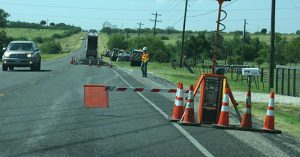The Texas Department of Transportation (TxDOT) recently initiated the use of two new safety tools that are available to county road crews: Automated Flagger Assistance Devices (AFADs) and Work Zone Temporary Rumble Strips.
An AFAD is a “flagger assist” device that allows flaggers to remotely control traffic while being positioned out of the lane of traffic. In an era in which drivers face many distractions, the Work Zone Temporary Rumble Strips, which can be both felt and heard, help to alert drivers and gain their attention.
AFADs are a relatively new device. In late 2004 and in early 2005, the Federal Highway Administration (FHWA) issued interim approval memos for the optional use of AFADs “to reduce flagger exposure to highway user traffic.”
Since that time, the use of AFADs has been incorporated into the Federal Manual on Uniform Traffic Control Devices and into the Texas Manual on Uniform Traffic Control Devices (TMUTCD). As stated in the FHWA’s approval memo, “The primary benefit is to enhance the safety of flaggers while also maintaining positive control of traffic approaching the Temporary Traffic Control Zone.”
There are two types of AFADs: a STOP/SLOW AFAD, and a Red/Yellow Lens AFAD.
To stop traffic, the Red/Yellow Lens AFAD displays a red lens, and a gate arm with a flag then lowers across the lane.
To release traffic, the Red/Yellow Lens AFAD displays a flashing yellow lens, and the gate arm raises.
Maintenance on two-lane, two-way rural roads is typically done by closing down one side of the road for repair, with traffic flow in the other lane alternating under the control of flaggers. Flaggers are still present when AFADs are used, but with one big difference: The remote control feature of the AFADs allows the operator/flagger to be positioned out of the lane of traffic. The flagger is also relieved of the job of holding the STOP/SLOW paddle and other related duties.
In addition to allowing the flagger to be positioned away from traffic, the AFAD system has the inherent advantage of allowing the flaggers to put more of their focus and energy into observing and controlling traffic – a substantial safety benefit to both drivers and workers.
The TMUTCD includes several stipulations regarding the use of AFADs including the following statement: “AFADs should not be used for long-term stationary work (work that operates a location more than three days).”
Work Zone Temporary Rumble Strips
In November 2012, TxDOT developed the new Work Zone Temporary Rumble Strip standard sheet, WZ(RS)-12, for use on temporary lane closures to enhance safety. The temporary rumble strips are to be used on one-lane, two-way flagging operations with a posted speed limit of 70 mph or less, and lane closures on conventional highways with a posted speed of 70 mph or less.
A warning sign precedes the Work Zone Temporary Rumble Strips.
Temporary rumble strips can be both felt and heard, and help to command the drivers’ attention.
In summary:
AFADs allow flaggers to be further separated from harm’s way.
By freeing flaggers of the duty of holding the STOP/SLOW paddle, the AFADs allow flaggers to operate much more as “traffic controllers” who focus their efforts on traffic control and promote safe conditions for both drivers and workers.
AFADs are mechanical devices placed in a stationary position adjacent to the traffic lane. They deliver a uniform, clear, and consistent message. Yes, this can be achieved through the use of a flagger using a conventional STOP/SLOW paddle, but the mechanical nature of the AFAD operation helps to minimize the risk of human errors.
Drivers face many distractions today, and the Work Zone Temporary Rumble Strips help alert drivers and command their attention. H
















